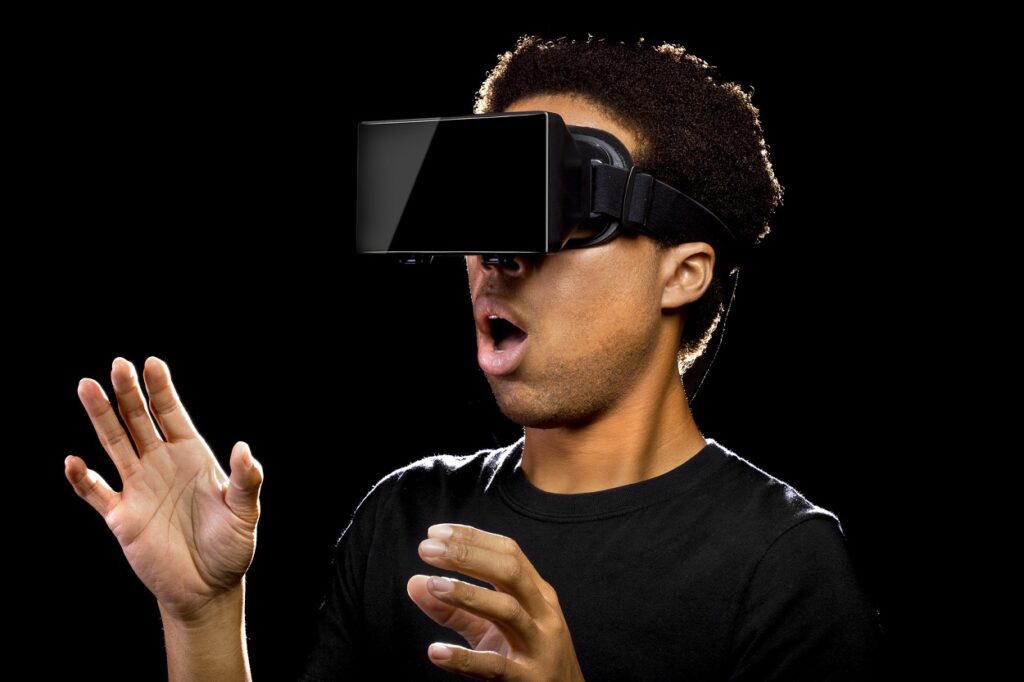Every so often, a new technology comes along that promises to transform the way we learn. This year it’s virtual reality’s turn to step into the spotlight. With Oculus Rift and other cheaper VR headsets now available for mainstream gaming, 2016 has been dubbed the year of VR. But does VR really have a place in today’s learning strategies? Is it capable of revolutionising mainstream corporate learning, or is it just hype?
Earlier this summer, Kallidus surveyed more than 200 L&D professionals to find out what they really think about the use of VR in workplace learning.
Firstly, the survey revealed that nine out of 10 L&D professionals plan to use VR for learning in their organisation, with over a third planning to roll VR out over the next three years.
Only 8% said they feel VR is ‘just hype’; 81% think it has ‘real potential’, and a further 11% are prepared to go one step further, calling VR out as the ‘next big thing’ in learning.
The majority (95% of respondents) see VR as being useful for enhancing L&D.
So why the keen interest given VR is yet to prove its worth in corporate learning?
And how has it managed to capture the imaginations of today’s L&D professionals when other emerging learning techniques like mobile have yet to really take off?
The answer lies in the fact that L&D professionals see VR as having the potential to add something innovative and special to the learning mix.
81% of L&D professionals agreed one of the biggest benefits of VR lies in helping their organisation to be more innovative, and, at last, provide learners with something truly innovative at a time when other internal corporate functions are struggling to offer consumer-grade technologies that people now expect from all aspects of their lives.
In terms of key benefits, innovation was only topped by VR’s potential to make high-risk or impractical training achievable (84%) and for its role in immersing learners and achieving the ‘holy grail’ of greater engagement (89%).
What I find particularly encouraging is just how open minded L&D professionals are about using VR in their organisation.
As expected, the majority (64%) plan to use VR for developing technical skills (where VR has always had its roots), however, onboarding and orientation (41%); operational and interpersonal skills (both 39%); leadership development (36%) and customer services/sales skills (35%) also have significant appeal.
I think the real potential for developing mainstream learning applications will be using 360-degree VR and other immersive techniques to transport the learner into someone else’s shoes for onboarding programmes and developing core ‘soft’ skills.
With these types of initiatives, it is plausible that VR will leapfrog other learning technologies in terms of both speed and scope of adoption.
Indeed, over half (53%) of respondents have VR at the top of their list as the next new mode of learning they most want to implement, ahead of virtual classrooms, mobile learning, games-based learning and social learning in terms of priority.
There are bound to be challenges – the survey showed perceived costs, lack of knowledge on how to use the technology and lack of cultural appetite are the biggest barriers – but these appear not to be deterring L&D teams from embracing VR.
If you’re looking to get started with VR, here are 10 tips to consider:
- Keep the needs of the learners at the heart of the solution – align VR capabilities with desired learner outcomes.
- Define what unique experience VR will offer over and above the training options you might have considered in the past.
- Focus on using VR to encourage people to try new things, solve problems and master their environment.
- Think about how to use VR to make learning more engaging, motivating and fun.
- Consider optimum learning time: content should be bite-sized and limited to 5-6 minutes at most.
- Break down complex situations into smaller, digestible chunks.
- For high-precision specialist training, it’s best to invest in high-tech headsets like Oculus Rift or HTC Vive.
- For training on a larger scale, use budget-friendly headsets – such as the Google Cardboard – which are best suited to narrative content using branching scenarios to allow learners to make choices and see the consequences of their actions.
- If you’re experimenting with filming content, it’s important to start off with a static camera. Make sure you give the learner a central focus point to keep them grounded in the learning.
- Lastly, don’t get sidetracked by the excitement of the technology – content is still king.
VR is poised to be the next transformational learning technology and a game-changer for training and development. Only time will tell whether it really is the next big thing, but what we can be sure of is that L&D professionals are excited about VR’s potential and are keen to embrace it to push the boundaries to deliver more innovative and engaging learning experiences.
Every so often, a new technology comes along that promises to transform the way we learn. This year it’s virtual reality’s turn to step into the spotlight. With Oculus Rift and other cheaper VR headsets now available for mainstream gaming, 2016 has been dubbed the year of VR. But does VR really have a place in today’s learning strategies? Is it capable of revolutionising mainstream corporate learning, or is it just hype?
Earlier this summer, Kallidus surveyed more than 200 L&D professionals to find out what they really think about the use of VR in workplace learning.
Firstly, the survey revealed that nine out of 10 L&D professionals plan to use VR for learning in their organisation, with over a third planning to roll VR out over the next three years.
Only 8% said they feel VR is ‘just hype’; 81% think it has ‘real potential’, and a further 11% are prepared to go one step further, calling VR out as the ‘next big thing’ in learning.
The majority (95% of respondents) see VR as being useful for enhancing L&D.
So why the keen interest given VR is yet to prove its worth in corporate learning?
And how has it managed to capture the imaginations of today’s L&D professionals when other emerging learning techniques like mobile have yet to really take off?
The answer lies in the fact that L&D professionals see VR as having the potential to add something innovative and special to the learning mix.
81% of L&D professionals agreed one of the biggest benefits of VR lies in helping their organisation to be more innovative, and, at last, provide learners with something truly innovative at a time when other internal corporate functions are struggling to offer consumer-grade technologies that people now expect from all aspects of their lives.
In terms of key benefits, innovation was only topped by VR’s potential to make high-risk or impractical training achievable (84%) and for its role in immersing learners and achieving the ‘holy grail’ of greater engagement (89%).
What I find particularly encouraging is just how open minded L&D professionals are about using VR in their organisation.
As expected, the majority (64%) plan to use VR for developing technical skills (where VR has always had its roots), however, onboarding and orientation (41%); operational and interpersonal skills (both 39%); leadership development (36%) and customer services/sales skills (35%) also have significant appeal.
I think the real potential for developing mainstream learning applications will be using 360-degree VR and other immersive techniques to transport the learner into someone else’s shoes for onboarding programmes and developing core ‘soft’ skills.
With these types of initiatives, it is plausible that VR will leapfrog other learning technologies in terms of both speed and scope of adoption.
Indeed, over half (53%) of respondents have VR at the top of their list as the next new mode of learning they most want to implement, ahead of virtual classrooms, mobile learning, games-based learning and social learning in terms of priority.
There are bound to be challenges – the survey showed perceived costs, lack of knowledge on how to use the technology and lack of cultural appetite are the biggest barriers – but these appear not to be deterring L&D teams from embracing VR.
If you’re looking to get started with VR, here are 10 tips to consider:
- Keep the needs of the learners at the heart of the solution - align VR capabilities with desired learner outcomes.
- Define what unique experience VR will offer over and above the training options you might have considered in the past.
- Focus on using VR to encourage people to try new things, solve problems and master their environment.
- Think about how to use VR to make learning more engaging, motivating and fun.
- Consider optimum learning time: content should be bite-sized and limited to 5-6 minutes at most.
- Break down complex situations into smaller, digestible chunks.
- For high-precision specialist training, it’s best to invest in high-tech headsets like Oculus Rift or HTC Vive.
- For training on a larger scale, use budget-friendly headsets - such as the Google Cardboard - which are best suited to narrative content using branching scenarios to allow learners to make choices and see the consequences of their actions.
- If you’re experimenting with filming content, it’s important to start off with a static camera. Make sure you give the learner a central focus point to keep them grounded in the learning.
- Lastly, don’t get sidetracked by the excitement of the technology - content is still king.
VR is poised to be the next transformational learning technology and a game-changer for training and development. Only time will tell whether it really is the next big thing, but what we can be sure of is that L&D professionals are excited about VR’s potential and are keen to embrace it to push the boundaries to deliver more innovative and engaging learning experiences.





